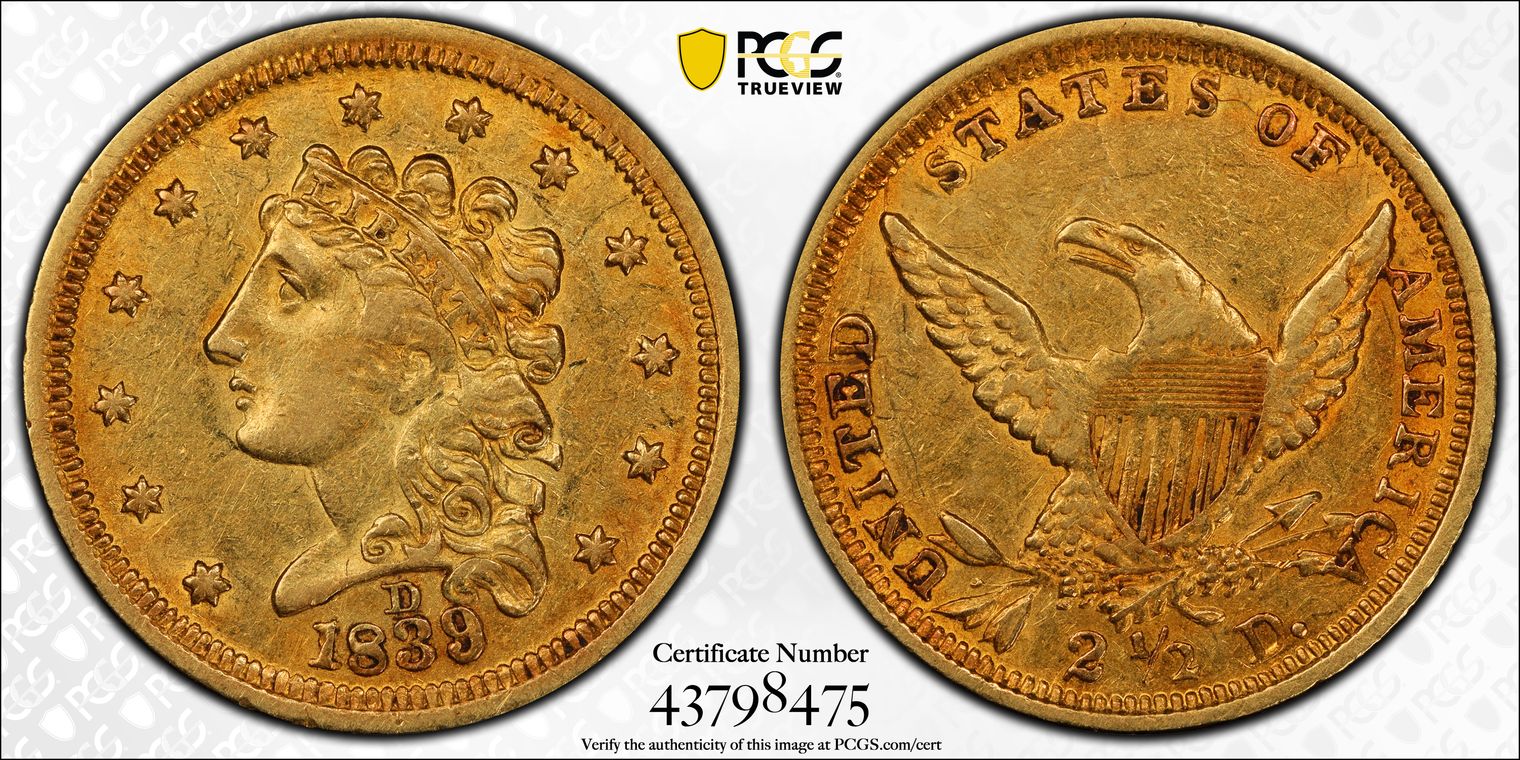1839-D $2.50 AU55 认证号43798475, PCGS号7700
拥有者评论
CAC
专家评论
David Akers (1975/88)
Comparable in overall rarity to the 1838-C, but as the auction records indicate, actually more difficult to obtain in high grades. Although I did not personally examine the piece, the description and photo of the coin in Lester Merkin's April 1970 sale indicate that it was very choice, perhaps the finest known. I have not seen a strictly uncirculated specimen, but I have examined two choice AU's. As mentioned earlier, the head on the 1839-D quarter eagle is identical to that which appears on the 1838-C. The majrity of specimens that I have seen are softly struck on the hair curls around the ear and on the eagle's right wing at the junction of the wing and shield. Definitely underrated in high grade since this is the rarest date of this type in grades better than EF.Doug Winter
The 1839-D is popular due to its status as the only Classic Head quarter eagle struck at the Dahlonega Mint. It is also the only Dahlonega mint issue of this denomination with the mintmark located on the obverse.The 1839-D quarter eagle is generally seen in Very Fine and Extremely Fine grades. About Uncirculated examples are scarce but are more plentiful than once believed. This date is rare in the higher About Uncirculated grades and it is very rare in Mint State. One superb Uncirculated coin is known.
STRIKE: In comparison to the other mintmarked issues of this design, the 1839-D quarter eagle shows a relatively sharp strike. The obverse border is unusually broad and configured unlike any other Classic Head quarter eagle. The denticles are long and sharp and have a unique shape. The central details on the obverse are fairly bold, including the hair over the ear, which is mostly full. The stars are somewhat flat at the centers but sharp at the points. The strike on the reverse is not as full as on the obverse. The feathers are weak near the shield and on the left wing tip. The shield is fairly well detailed with the exception of the horizontal lines. The arrow shafts are weak and the heads of the arrows are somewhat faint.
SURFACES: Most 1839-D quarter eagles are noticeably abraded in the fields. It is not unusual for higher grade examples to display conspicuous marks or scratches. Mint-made planchet problems are not uncommon. All examples show light clashmarks within the ear of Liberty. The first star is repunched.
LUSTER: This date usually shows bright, frosty luster. Some have slightly subdued grainy luster.
COLORATION: Uncleaned, original 1839-D quarter eagles exhibit an attractive orange-gold color. Some show coppery overtones as well. It has become increasingly difficult to locate a piece with natural color as more and more are being cleaned or dipped.
EYE APPEAL: It is still possible to find an example with above-average eye appeal. This date comes better struck than other Classic Head issues (including some of the Philadelphia dates) and has nice luster and color.
PERSONAL OBSERVATIONS: The 1839-D quarter eagle is one of five one year only issues from the Dahlonega mint (the others are the 1855-D gold dollar, the 1854-D three dollar gold piece, the 1838-D half eagle and the 1839-D half eagle). This has always made it an immensely popular coin. The James Stack coin, now owned by a prominent western collector, is by far the best I have seen. It brought a then-remarkable $55,000 when auctioned in 1994.
DIE VARIETIES: Two varieties are known, employing one obverse and two reverses.
The obverse has the mintmark located below the bust and over the 3 in the date. The 3 is doubled inside the upper loop while the 9 touches the curl and is far from the denticles. The digit was improperly cut and it looks as if the date were 1839/8. This is incorrect and this has been improperly labeled as an “1839/8” overdate for many years.
All 1839-D quarter eagles have a wide gauge reading that distinguish them from their Philadelphia, Charlotte, and New Orleans counterparts.
Variety 1-A: The obverse is described above. The reverse is identifiable by a weak branch stem that extends over to the upright of the D in the denomination. This is the more common of the two varieties.
It is estimated that approximately 8,000 examples were struck using this reverse.
Variety 1-B: The obverse is the same as on Variety 1-A. The reverse is identifiable by a bold branch stem located entirely to the left of the D in the denomination. This reverse develops a crack that runs from the rim through the upright of the second T in STATES and through the field to the eagle’s head. A second crack runs through the base of the letters in UNITED and then out into the field to the right of the D in this word. A third crack can be seen from the tip of the left wing up into the denticles and the rim.
This is the rarer of the two varieties. It is estimated that approximately 5,500 were struck using this reverse.
PCGS #
7700
设计师
William Kneass
边缘
Reeded
直径
18.20 毫米
重量
4.18 克
铸币数量
13674
金属成分
90% Gold, 10% Copper
更高评级数量
26
评级较低的钱币数量
150
地区
The United States of America
价格指南
PCGS 数量报告
拍卖 - PCGS 评级的
拍卖 - NGC 评级的
稀有性和存量估计 了解更多
| 所有评级 | 200 |
| 60或以上 | 8 |
| 65或以上 | 0 |
| 所有评级 | R-7.0 |
| 60或以上 | R-9.6 |
| 65或以上 | R-10.1 |
| 所有评级 | 3 / 11 |
| 60或以上 | 2 / 11 TIE |
| 65或以上 | 1 / 11 |
| 所有评级 | 3 / 11 |
| 60或以上 | 2 / 11 TIE |
| 65或以上 | 1 / 11 |






















